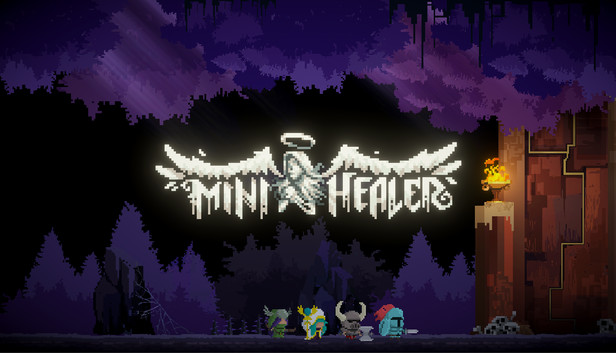A detailed look at Poison: how it works, the associated talents and uniques, and how to build it.
Part 0. Why Play Poison?
Pros
- It has incredibly high damage potential even with unideal equipment.
- It has a very different damage output style than many other builds, being over time rather than up front.
- It has good build diversity for a single talent thanks to its plentiful uniques.
- Poison is the only damaging effect that has an Augment that improves it specifically.
- Poison can reach the damage reduction cap in the postgame.
- The entire game can be completed with Poison.
Cons
- Because poison requires damage stats to deal damage (as opposed to scaling from Healpower or character health), you will likely sacrifice damage to live.
- Poison has many unique armors with woefully low mitigation stats, exacerbating the previous issue.
- Depending on the build style, it is a bit of a slower farmer because you need to wait for poison to deal its damage.
- The highest builds of poison require well-rolled non-unique items, increasing the barrier of entry.
Part 1. The Basics of Poison
In this section, the basic mechanics of Poison are described. This includes a brief description of the associated talents, a detailed look at how the poison damage-over-time effect functions, and the equation for calculating the damage of a poison tick (and the implications thereof).
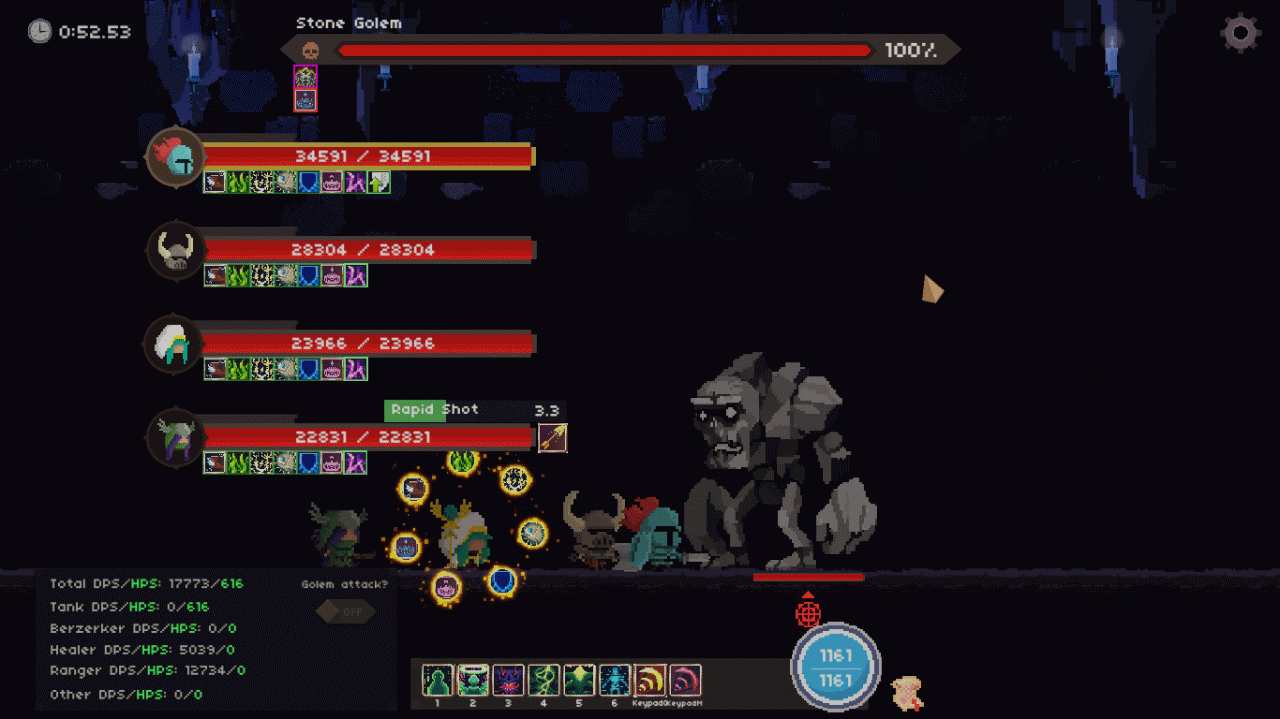
Part 1A. The Talents
Poison has two main talents: Poison and Poison Making. Poison can be obtained extremely early in the game, with Poison Making opening slightly later.
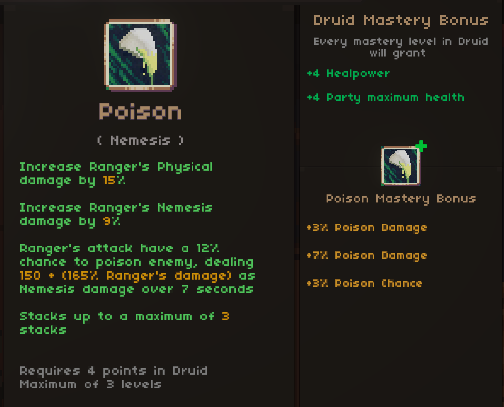
The following effects of the Poison talent scale per talent level:
- Ranger Physical % (+5% per rank)
- Ranger Nemesis % (+3%)
- The base damage of the Poison debuff (+50)
- The % of Ranger’s damage added to the base Damage (+55%)
- The maximum number of stacks of poison that can be on a target (+1)
The following effects do not change per talent level:
- The chance of applying the Poison debuff (15% total with level 3 mastery)
- Only Ranger applies the poison.
- Poison has a set duration of 7 seconds.
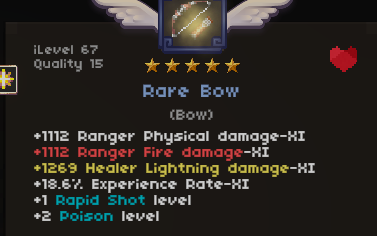
Non-uniques (Greens, blues, and purples with generic names), as well as some unique armors, can roll +Poison level. For non-uniques, this can occur with any weapon type and any relic type. Unique sources of +Poison level, as well as the implications of gaining further levels of poison, will be discussed later.
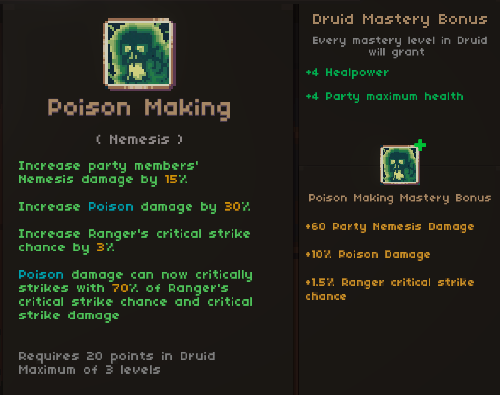
Poison Making is very good and should always be taken when playing poison. There are no external effects that interact with this talent, and everything in the guide assumes that this talent is taken with 3 points once you have access to it.
Part 1B. The Mechanics
Poison has many moving parts that all can be manipulated by uniques. These mechanics are summarized below.
Application Chance
- With a basic level 3 Poison with 3 mastery, Ranger’s auto attacks have a 15% chance to apply poison each attack. Although Ranger has a naturally higher attack speed than the other party members, Poison application can be inconsistent without support.
- Many poison uniques have +% Poison Chance, which is additive with the talent and its mastery. If your poison chance becomes 0 or lower, you cannot apply poison with auto attacks.
- Non-uniques cannot gain +% Poison Chance in any way.
Stacks and Overcapping
- Stacks of buffs and debuffs are independently tracked in MiniHealer. Applying stacks of poison does not reset the duration of older poison buffs.
- Poison can stack up to your poison stack cap, which is the sum of any +/- maximum Poison stack on your equipment plus any stacks you gain from the talent. If your maximum Poison stack would become 0 or lower, you cannot apply poison in any way.
- If poison would be applied and your poison stack is currently capped, it will only deal its application tick damage.
- Stacks applied simultaneously will tick simultaneously.
Poison Tick Structure
- Poison deals damage in individual ticks over its duration. The number of ticks is equal to 1 + its duration. A 7-second (default) poison will deal its damage in 8 ticks. Refer to the .gif above.
- Poison ticks occur every one second after the stack’s application (excluding the application tick). This tick rate cannot be increased.
- The first tick is immediately on application, while the last is immediately on expiration. The existence of the expiring tick is important for understanding why one poison unique (Netherlight) does not perform very well.
- Like the overwhelming majority of things in MiniHealer, Poison does not snapshot stats on application. If the Ranger gains or loses damage or the enemy gains resists after poison is applied, all active poison stacks will update their damage.
- Thanks to Poison Making, each tick of poison has a chance to crit, dealing increased damage. One tick critting does not alter the damage subsequent ticks will do.
Damage Source
- In MiniHealer, the “damage source” refers to which character’s stats are used to calculate the damage of a skill or effect. Oftentimes, effects that are “casted” by a character are owned by that character, while effects that are “triggered” are owned by the original owner of that skill.
- The damage source of most skills and abilities can be found by viewing the combat log.
- All poison uniques that allow other party members to apply poison are considered “trigger” uniques, so the Ranger always owns Poison damage.
Part 1C. The Damage Calculation
The damage formula can be generalized as follows. Note that the form below is based on how I would typically equip and talent a poison build, so not every item and unique effect is included.

The critical damage multiplier (gained through Poison Making) is, unsurprisingly, multiplicative with the rest of the formula. The following term can be multiplied into the above equation to obtain the critical damage of one poison tick:
If we were to summarize this un-mathematically into its basic parts:
Your poison damage depends primarily on your poison level and your ranger’s total base damage. This is scaled multiplicatively by the following factors.
- The sum of all increases to poison damage,
- The Ranger’s total relevant (Ice or Nemesis) damage modifier, which is the sum of that modifier for the ranger only plus the same modifier for the whole party,
- The sum of any generic (% damage without a specific type) modifiers, such as Aura Mastery and Decay Aura,
- 70% of the Ranger’s effective critical damage multiplier when the tick crits. Effective critical damage is any critical damage multiplier above 100%. The added 1 is adding back the 100% that was not factored in the 70% calculation originally.
- The enemy’s resistance to your poison damage type. If that resistance is negative, poison will deal more damage.
The main takeaways from this math are:
- Ranger base damage is the core of poison’s damage. Without good ranger damage, poison is fairly weak.
- Every poison level greatly increases the portion of Ranger’s base damage used in the damage calculation, making +Poison levels extremely potent.
- Aura mastery increases your damage for each aura you have, making it an easy way to get a larger multiplier and lots of aura effect for Decay Aura.
- While Poison does not get full benefit from crit multiplier, it is still one of the largest multipliers available and is worth investing in.
Interested in exploring the math yourself? Check out my Poison damage calculator[docs.google.com].
Poison has one of the largest unique pools in the game for a single skill. Additionally, it gains a lot of power from non-unique items.
Poison uniques can be generally broken down into three categories:
- Appliers, which primarily function to put poison stacks on the target,
- Payoffs, which give you some benefit for putting stacks on the targets, and
- Utilities, which allow you to manipulate your poison stacks.
Items are roughly sorted in the order you would encounter them as you initially progress through the game.
Part 2A. Appliers
A typical poison build should have at least one applier to improve or guarantee applying poison.
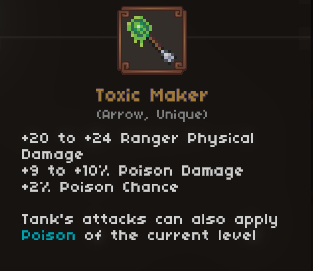
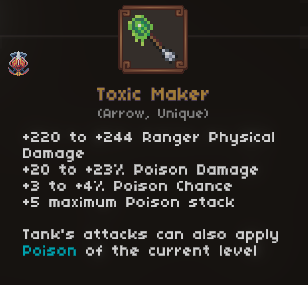
Toxic Maker is likely the very first poison unique you will run into journeying through the vault. It can be upgraded to its ‘Divine’ form after gaining access to Lowmore.
- As an attack speed-based Applier, this suffers some inconsistency issues. With too much attack speed, it can be prone to overcapping your stacks.
- Remember that regardless of who applies the stacks, all poison damage is based on the Ranger.
- The divine form of this item is very efficient if you are looking to get a boost to your maximum poison stack.
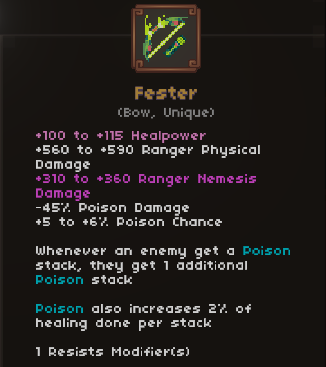
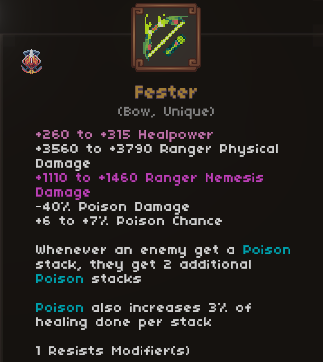
Fester can be found early in the game and has a divine upgrade. It is the first of many poison items with a distinct tradeoff. For any build looking to be around stack cap often, it is a solid choice.
- The reduction to Poison damage is additive with other sources of +% Poison damage. If you have no sources of +% Poison damage, your poison will deal 55% (or 60%) of its normal damage.
- If a source would apply multiple stacks at once, it applies 2x/3x as many stacks instead.
- This item is prone to overcapping your stacks with only a little investment.
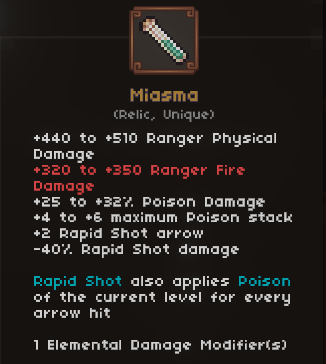
Miasma is the backbone of many non-attack speed variants of poison.
- All stacks applied by Rapid Shot are applied simultaneously.
- Rapid Shot will apply poison even if your application chance is 0.
- With its base cooldown, Rapid shot will maintain a poison stack equal to your number of rapid shot arrows on the target. With Prolonged Poison, it will maintain double that.
- The number of poison stacks added is equal to your number of Rapid shot arrows. This will usually be a minimum of 6, plus the 2 from the item, plus any additional arrows from your talents, weapons, or relics.
- This item is prone to overcapping if you have a low maximum poison stack or are running the Windforce bow (Ranger attacks have a chance to trigger Rapid Shot).
- Rapid shot always has a 9-11 second cooldown at the start of a fight, making farming with Miasma slow even with strong poison builds.
Part 2Ai. Hornet
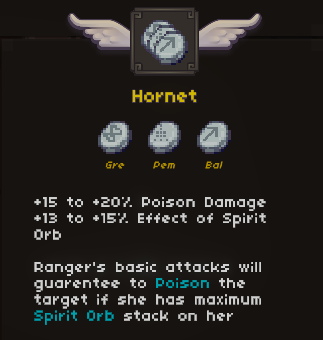
Hornet is poison’s runeword. To make this runeword, you will need an Uncommon (green) weapon with three rune (egg-shaped) slots. Slot the runes in the correct order and the uncommon will become unique and take on the powers of the runeword, while retaining its original stats. Removing any of the runes will revert the item back into its base form.
Hornet is, on paper, posion’s best applier unique. With only a trivial investment in attack speed, Hornet can easily cap poison stacks, opening itemization towards crit and crit multiplier.
However, practically, Hornet is extremely difficult to apply outside of fighting the target dummy golem. The primary issues come from:
- Applying Spirit Orbs
- Maintain the capped spirit orb stack. Note that the base stack size is 2.
Applying Orbs is an issue of incremental costs. There are a decent number of ways to apply them:
1. Spirit Orb (the skill). After a short cast time, you apply an orb that remains for 25 seconds or until the target takes damage (not health loss).
- Without any uniques, 2 spirit orbs would need to be manually casted onto the ranger every ~20 seconds to maintain maximum stacks. This, of course, requires running the Spirit orb skill itself, which is not very good.
- The Replica runeword (relic slot) provides a 60% chance to apply an additional orb when applying spirit orbs, but this is inconsistent when applying only one orb at a time and spends a highly competitive accessory slot.
2. Lesser Heal through Foresight. Lesser Heal applies 4 stacks of Spirit orbs, but Foresight also extends the orb stack cap by 4 (up to 6 from base).
- 2 casts of Lesser heal are required to cap with this, though Replica can smooth it substantially. Replica rolls its 60% chance for each individual orb.\
- Spending a weapon slot is unideal, as bows are the primary source of ranger base damage and % ranger nem/ice damage.
- Lesser Heal has a low cooldown and cast time, making it a great option besides the aforementioned damage loss.
3. Radiant Heal through Favor of Light. Radiant Heal applies 2 Orbs to all party members. The item does not extend the orb cap.
- Only one cast is required to cap orb stacks if no other Spirit orb uniques are ran with it.
- Radiant Heal has a long cast time and cooldown, which can make reapplying orbs difficult if they are detonated early.
- Defensively, Favor of Light is a reasonable option, but it competes with Poison’s armor options.
4. The Faithful. A weapon that applies a spirit orb to each party member every 8 (6 with divine) seconds.
- The deadtime between applications can be an issue, but can be mitigated with manually casted Spirit Orbs and Replica.
- As a weapon, the same downsides as Foresight apply.
5. Seal of Light with the Glimmer of Hope talent. Seal of Light is a new healing skill for the paladin tree. When a target marked with a seal is healed by Divine Mend (pally’s basic heal) or Hammer of Reckoning is cast, the seal will detonate, dealing a small amount of fire damage and healing the sealed target. With Glimmer, the sealed target also gains one Spirit Orb when the seal is consumed.
- Seal itself has a short cooldown and only applies one orb at a time without replica, making it a bit slow compared to other options.
- Seal combos are somewhat mana-intensive, which can be an issue depending on how you decide to sustain mana (Demonic Contract or Rejuvenation)
- Taking Glimmer requires 8 points in Paladin first, but those 8 points provide good stats.
Maintaining your stack of Spirit orbs is a major issue. I have identified three options to help maintain a max orb stack:
1. Don’t get hit. Blocked or dodged hits do not trigger orbs, but there isn’t much control over this. For most encounters, this is good enough since not everything has party-wide multihit attacks.
2. The Delayed Redemption relic prevents orbs from detonating to damage while also extending the Orb stack cap by 3.
- Orbs will still heal, but at their expiration time 20 seconds after application instead.
- Increasing the orb cap means that your orb appliers need to apply more. Foresight requires an additional cast to cap orbs when DR is equipped.
- DR takes up an extremely competitive relic slot, so it may hurt your damage.
3. Shields
- In 0.6, Spirit Orb behavior has changed: Orbs on shielded targets will not detonate until the shield is consumed or expires. Pure in Heart can turn healing crits into shields, allowing Orbs to protect each other. The shield size will vary depending on how much you invest into your critical heal multiplier.
Overall, Hornet is a poorly explored option due to its difficult restrictions. However, with the change to Spirit Orbs and shields and the addition of a new application method in Seal of Light, Hornet may shine in 0.6.
Part 2B. Payoffs
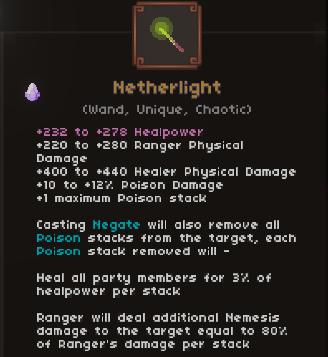
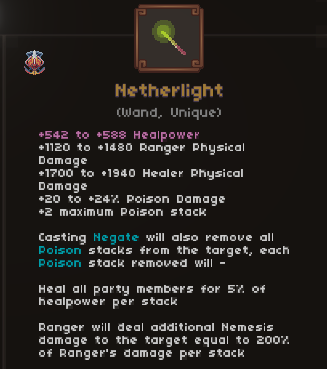
Netherlight is a hybrid Utility/Payoff that rewards casting Negate on your target while poison is active to gain its benefits.
- Poison stacks will immediately stop dealing their damage when removed.
- At minimum, the final tick of poison will always be lost with optimal Negate timing.
- Both effects are additive. Removing a 5 stack of poison with a Divine Netherlight will heal the party for 25% healpower and deal 1000% (200 * 5 in one hit) ranger damage.
Netherlight creates a different gameplay loop and is most effective with Miasma:
- Wait for the Ranger to apply poison using Rapid Shot.
- Right before that set of stacks expires, cast Negate to remove the stacks.
With typical Poison itemization, which focuses on improving the Poison damage-over-time effect itself, Netherlight ends up being a dud of an item because it does not scale with Poison’s damage. With sufficient poison level and effect, damage dealt by set of poison stacks’ last tick can exceed that of Netherlight, rendering the offensive portion of the item pointless. The damage loss from Netherlight is exacerbated if you cast Negate at the wrong time, or your auto attack applies stacks after Rapid shot (i.e. some stacks are removed early).
For reference, a single tick of an optimized Poison can deal at least 3400% of Ranger’s total base damage. This leaves Netherlight in a gray area where it wants more stacks of poison, but other items that grant poison stacks also increase poison damage.
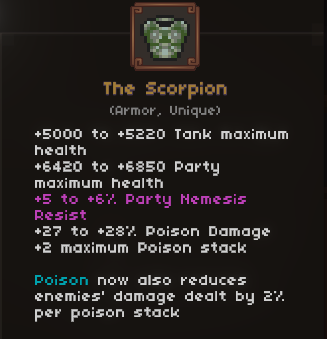
The Scorpion is poison’s primary defensive payoff.
- This damage reduction is additive with other sources of enemy damage reduction. Reductions to enemy damage dealt/damage taken from enemies has a floor of 1%.
- With Prolonged Pain and Miasma, you can typically maintain around 40% damage reduction, but the combined lack of resistances is not ideal. Compensate for this through talent choice.
- Some Damage-over-time and enemy area-of-effect attacks are not reduced by Scorpion. These are considered bugs and should be reported as they’re found.
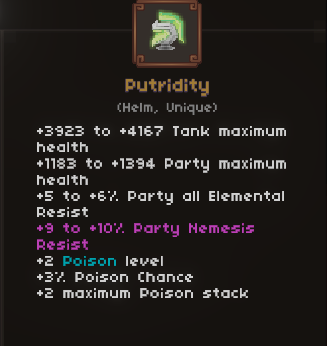
Putridity is a general poison goodstuff offensive option.
- Putridity is the only source of +Poison levels in the armor slot.
- While it is a great option offensively, enabling level 12 poison, it suffers from low health and resists compared to non-unique options.
- Between its poison levels and stacks, it provides +4 to your max poison stack.
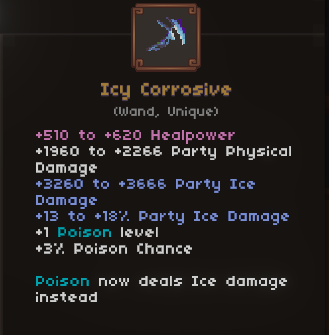
Icy Corrosive is a postgame-only unique that theoretically bridges the gap between Spirit orbs and poison
- Because % Ice damage modifiers are larger than % Nemesis modifiers, this is generally a damage upgrade over non-Ice poison (though this may change with access to better quality weapons through crafting).
- Because Poison deals Ice damage with this equipped, any bonuses to Nemesis damage, such as those found on the Poison/Making talents, do not support it.
- As mentioned in the Hornet section, dealing Ice damage allows Poison to benefit from the Frozen Sphere talent, which provides lifesteal and resistance reduction for ice.
Part 2C. Utilities and Other items
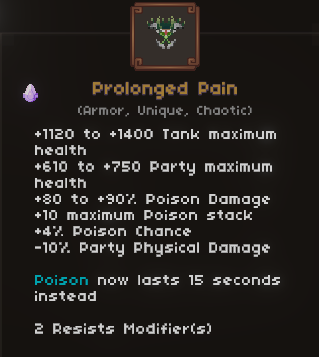
Prolonged Pain (PP) extends the duration of your poison stacks.
- By virtue of the massive % poison damage increase alone, this is a “damage per application” upgrade, but each tick will deal a little less damage than a regular poison tick.
- With its poor mitigation stats, Prolonged Poison can be a liability when run without Scorpion or a strong non-unique armor.
- PP is a very potent enabler for many payoff uniques. Some of its mitigation weaknesses are shored up by Scorpion, but neither bring strong resistances to the table.
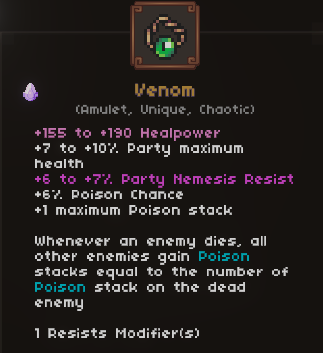
Venom is an excellent utility unique for clearing fights with multiple targets, such as the depths or Lom the Reanimator.
- Immune enemies also gain stacks. This can come in handy for bosses with multiple immune phases featuring an additional enemy.
- For what it does, it is solid. Swap this unique in and out as your farming requires.
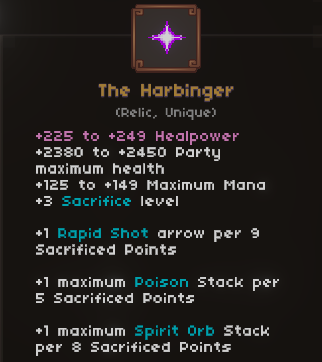
The Harbinger is a postgame item which is very undertuned relative to non-unique options.
- For reference, a blue non-unique relic can roll +2 poison levels (damage and +2 max stacks), +2 Rapid Shot arrows, a socket, and up to 5 other stats all at the same time.
- To match the number of poison stacks gained, you need to sacrifice 7 talent points.
- To match the number of rapid shot arrows, you need to sacrifice 15 talent points. You do get 3 poison stacks along the way, though.
- The payoffs for Sacrifice are generally weak and defense-oriented, though poison could use defense.
- In a nemesis-based poison build, this could warrant consideration, but should generally be avoided otherwise. The talent cost to match a non-unique which could also provide more health, damage, resistances, or whatever you like is quite high.
Part 2D. Anomalous Items
Anomalous items (Anoms) are alternate forms of existing items with slightly different effects. They share stats with their best form – anoms based on items with divine versions will have stats like the divine. These items can only be obtained as drops from the Anomalous Trio in the Infinite Corridor, the postgame area.
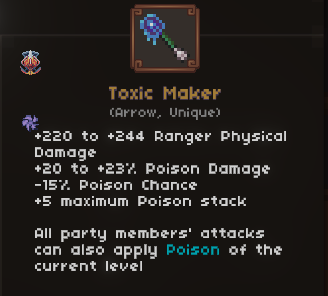
Anom Toxic Maker is the only item in the game with -% poison chance
- Without another applier unique, you cannot apply poison with auto attacks.
- Practically, this item adds the Healer to Toxic Maker, as Berzerker’s attacks are very, very slow.
- Overall, a reasonable option, but you will need to run 1-2 other poison uniques to repair your application chance.
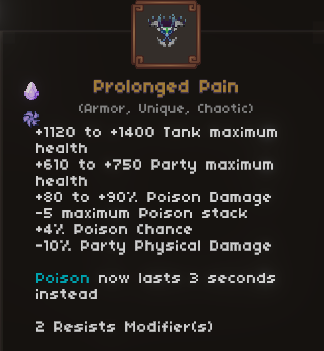
Anom Prolonged Pain is an amazing enabler. It is also the only source of -max poison stacks.
- By itself, this item converts poison from a slower, weaker individual hit DoT build to a potent burst damage build.
- The damage of individual ticks is massively increased compared to a regular poison, increasing the value of short-term controllable debuffs, such as Banish, Typhoon, or Frozen Sphere (Icy Corruption only).
- Like regular Prolonged Pain, Anom suffers from poor mitigation stats.
- Regular and Anom Prolonged Pain Poison stacks will deal the same total damage (before crits) over their duration, but Anom does it about 5 times faster.
- Without at least level 7 Poison or +3 to maximum poison stacks from other sources, you cannot apply poison with this equipped.
- This works well with any build that risks capping poison stacks. Conversely, it works quite poorly with Scorpion and Netherlight, which both care about having large stacks of poison constantly.
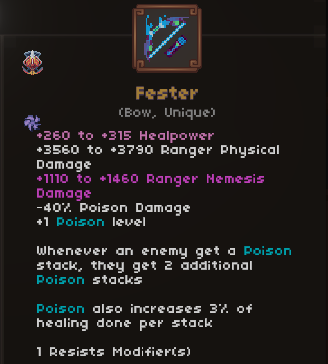
Anom Fester trades higher application rate for a rank of poison. You may consider running a second applier item to make up for the lost application chance, but high attack speed can fulfill the same role.
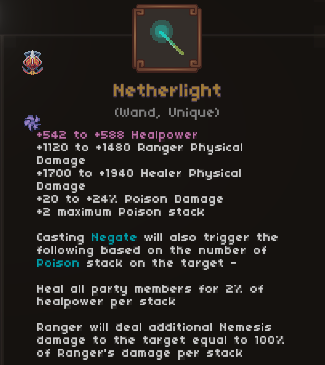
Anom Netherlight trades strength of effect for ease of use. Unlike its base form, Anom does not remove the stacks when Negate is cast.
- This removes the antisynergy with poison levels and damage. It still plays poorly with Icy Corruption because of non-matching damage types.
- Despite the usability and synergy improvements, it is still weak for the slot it occupies.
Part 2E. Non-uniques
Non-unique items are the backbones of most optimized builds due to their extremely high stats and diverse options. These items have several shared properties:
- Items roll random stats from a pool of stats allowed for that item type. A bow cannot roll the same stats as a sword, for example. +Levels to talents are considered a stat.
- Item affixes roll a tier from 1 (I) to 13 (XIII), with higher tiers being stronger. Higher tier items drop from higher level content, with tier 13s (t13s) becoming available in Lowmore and beyond. +Levels have a hidden tier, but it does not reflect whether they rolled +1 or +2.
- Non-uniques can roll sockets. The first socket rolls for “free”, meaning that it does not occupy a stat slot. Sockets 2 and 3 each take the place of a stat on the item. The named non-uniques (Star’s Recurve and Book of Dread) can roll sockets without losing stats.
- As with uniques, the strength of affixes depends on the quality of the item, with 25 being the highest total quality. Items with up to 15 quality can drop from chaotic enemies; crafting can add 5 quality; and mutation can add 5, for the total of 25.
Bows – Bows are preferred over Staffs because they can roll +%Nem/Ice damage for Ranger.
- Ranger base damage – Of these, Nemesis is the worst because it rolls lower than Phys, Ice, Light, or Fire of the same tier.
- %Nemesis or %Ice damage (with Icy Corruption)
- 3 sockets – Sockets are arguably the most important on weapons. Lategame gems provided 14% Party Nemesis damage (or 20% Party Ice) per gem, which essentially doubles the % damage value of those stats from each weapon.
- +Levels to Poison
- Other Ranger damage stats – Crit chance, crit damage multi, and attack speed (non-Miasma variants)
Armors
- If you aren’t running Prolonged Poison and Scorpion together, find a non-unique armor with good health, resists and healpower.
- Sockets provide additional resists and health, but aren’t as important as on weapons.
Relics
- +Poison Levels
- +Rapid Shot arrows for Miasma variants
- Defensive stats (health, resists, healpower, etc.) – Defenses can go a long way particularly when not running Scorpion.
Part 3. Leveling Tips
1. On Talents:
- If you want to minmax the first couple levels, put your talents into Dark Magic in Occultist until level 6. At level 6, swap into Conjuration and Poison.
- Once in druid, your goal is to get 3 points in Poison Making and Rapid Shot. Once those are done, switch back to filling in Occultist.
- I chose not to take Shadow Fury because it reduces Elemental base damage, which contributes to poison damage.
2. Spirit Ritual and Nature’s Gift can handle all healing issues. Towards the endgame, you may drop out Nature’s Gift in favor of spamming Spirit Ritual more.
- Blessing of Gaia is very strong and should be kept up on the Ranger as much as possible.
- Rejuvenate is mostly required by the endgame to have enough mana to complete the fights.
- Banish and Iron Vines are good options to fill the remaining spell slots.
3. Early on, Poison will not do very much damage. Before you have better Poison support and Bows, it will often be 3rd behind Rapid shot.
4. Prioritize sources of Ranger damage, Party damage, and Poison levels. A strong (large ranger base damage) bow without Poison is typically going to be better than a weak one with Poison.
5. Until guardians, if you are struggling on a fight, go beat whatever gives the most xp to get levels then go back.
6. In Hardcore, you can always quit out of or reset the fight when things are going unfavorably.
For Guardians:
1. Grind Depths (Abyss/Lowmore) for items with good Ranger damage rolls and +poison. Dice can be a reasonable alternative, but cannot roll as high tier as depths.
2. Prolonged Poison and Scorpion should be sufficient for your armor needs. These two together with some Poison ranks will apply a 36+% damage reduction from the bosses.
3.To comfortably complete the guardians, you want about 650k+ dps by 2 minutes when fighting the golem.
- Note that poison damage naturally fluctuates over time depending on how many stacks are applied with auto attacks.
- The reference build had 800k-1mill dps when first defeating Ignatius and Rusherrox. Sedok and Lom are much easier and can be done with half the DPS.
4. The reference build can do Aurdon without changing equipment. Just spam heals on yourself and target whichever demon isn’t reflecting. Target Aurdon when he is healing immune to speed up the fight by avoiding wasting the demons’ on-death healing.
Part 4. Example Builds
Non-boss room farming is about the same for all builds of Poison:
- Auto-attack appliers will generally be a bit faster than similar strength Miasma builds because they don’t need to wait for the initial cooldown on Rapid Shot.
- Anomalous Prolonged Pain builds will be faster than other variants simply because the damage is compacted into a 3 second dot instead of a 7 or 15 second one.
- Venom will accelerate floor clearing whenever there is more than one enemy in the fight.
Boss-specific Comments:
- Keto the Damned is an RNG fight for Poison builds without Toxic Maker. If the Ranger is Puppetified in phase 2 and you do not have a resurrection ability available, that attempt is over. This can be mitigated if you have enough DPS to bring Keto to 30% without interacting with his Crystal. This prevents him from healing at all, greatly reducing the length of phase 2.
- Goulron the Abomination, the pinnacle fight of the Sacrifice Grounds, likely requires Banish or Prolonged Pain + Scorpion to live through the Obliterating Curse (except for the final build listed here).
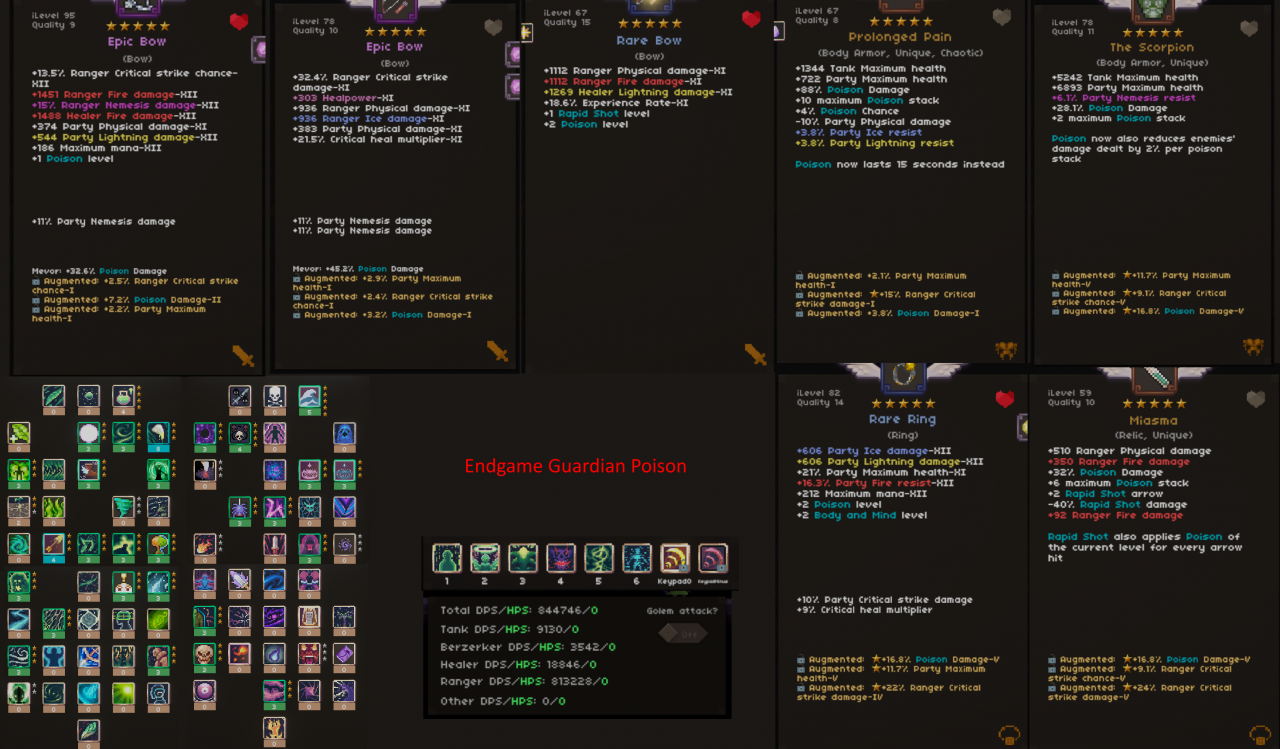
This build was used to defeat the guardians on Hardcore in preparation for writing this guide. Items are not fully optimized because I did not want to farm more than I felt necessary, so Stones of the Maker were in short supply (about 40 total by that point). The 33% Poison damage on bow was from crafting the damage before completing all of Mevor’s quests.
Looking to directly upgrade this build? See the “Standard Ice Poison” build for an optimized postgame version of this.
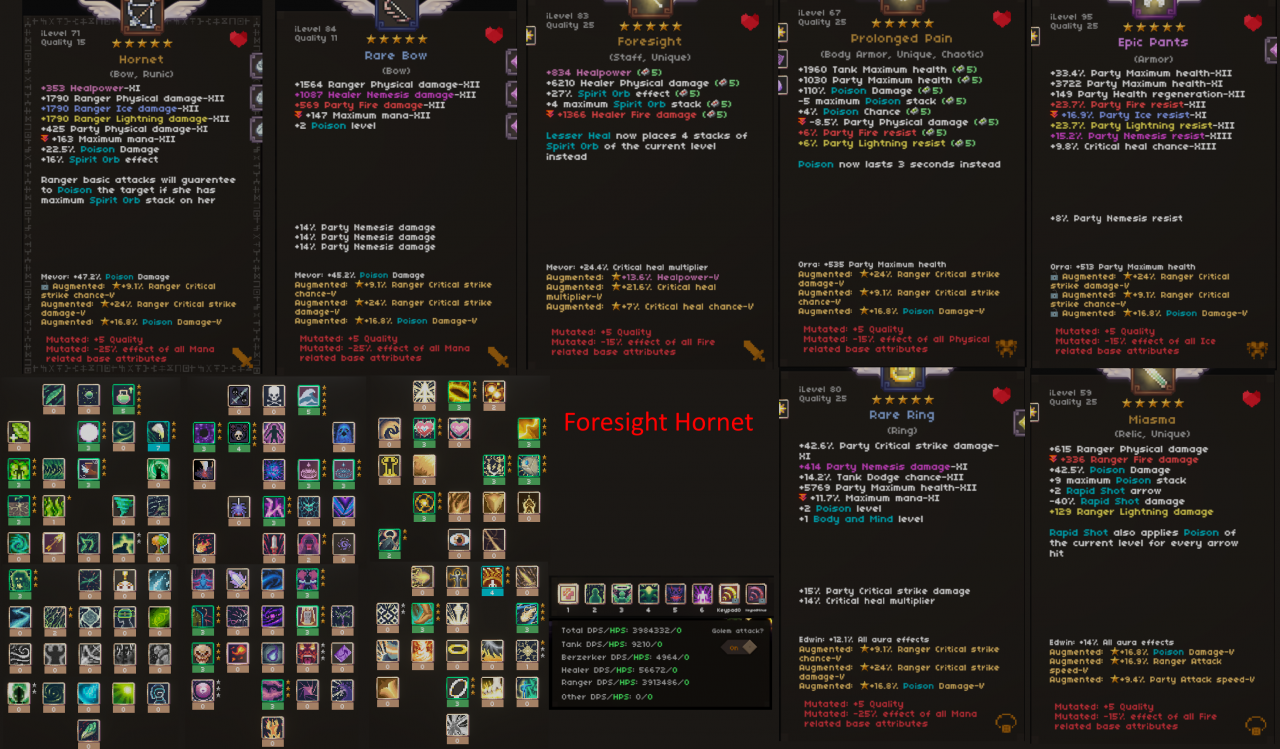
Items and Talents
- I chose to run Foresight as my Orb applier because it has no cooldown and a very fast cast time. The augments on Foresight are mostly because I use it in another build, but the critical heal chance/multi helps the healing/triggering Pure in Heart.
- The Hornet is on a legacy uncommon base. Legacy items can have up to 27 quality and their sockets do not follow the stat limits. An ideal modern Hornet base might have 3 non-nemesis base damages and % nemesis damage.
- Anomalous PP is basically required. Without it, too many stacks are lost to overcapping. For reference, a regular PP with the same quality and augments sustained half the DPS of the anom version.
- I chose Miasma primarily because it increases the Poison stack cap by 9, while also providing many other nice stats.
- The heavy splash into Priest is for critical heal chance to help orbs trigger Pure in Heart.
Gameplay
- This build is a bit tedious to play because of how Orb stack refreshing works: the orbs must entirely expire or otherwise be removed before they can be reapplied. New orbs applied at stack cap are wasted, rather than refreshing the duration.
- While Spirit Orb can do a lot of the healing, Spirit Ritual and Nature’s Gift are there for situations when Spirit Orbs cannot trigger.
- Ignatius absolutely requires Pure in Heart. His room’s constant fire damage will pop orbs not protected by shields.
- The secondary heals (SR and Nature’s Gift) are useful on Vagut the Butcher, whose primary mechanic involves health loss rather than actual damage.
I believe the ceiling on this build is much higher than this example, particularly using different orb application options (Seal of Light, for example) or switching to Ice.
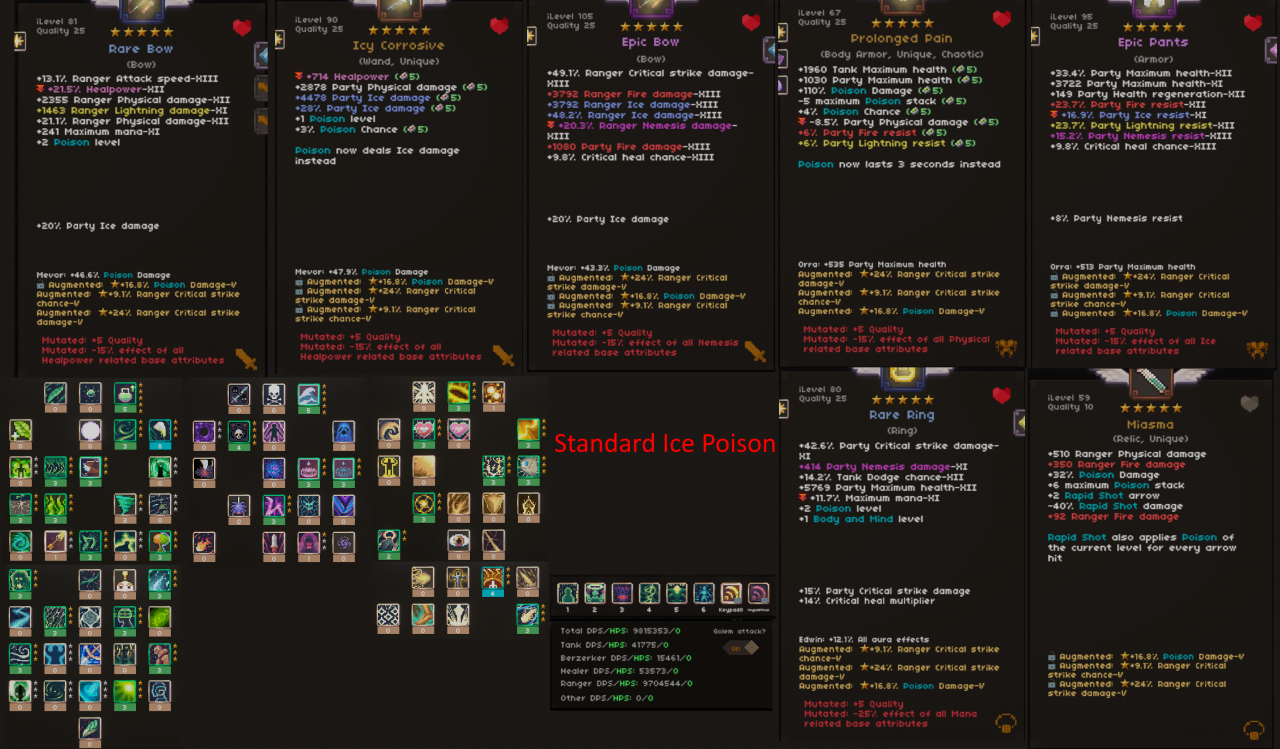
Item and Talents
- The rare bow is a legacy item, so I chose not to socket 2 gems during testing to give a fairer representation. 2 gems are worth 40% ice damage.
- – In this build, the Priest splash is for survivability through critical heals, since it does not benefit from the nemesis-related talents deeper in Occultist.
Gameplay
- No special gameplay patterns in this build. Keep your team alive and Gaia up on Ranger.
- Demonic Contract could be run instead of Rejuvenate to improve mana sustain.
This is a typical postgame Miasma-based Poison build. The better bows you find, the better the damage. Consider rearranging the talents to pick up more defenses as necessary.
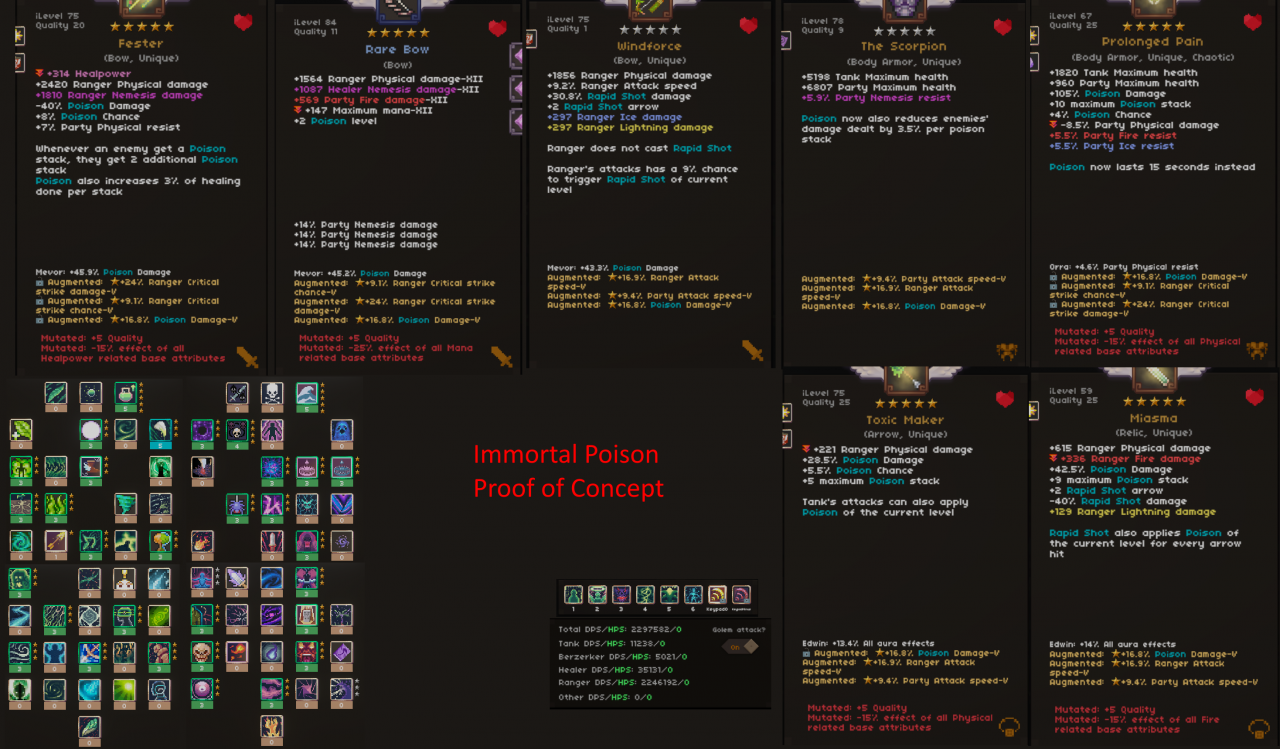
Item and Talents
- Talents are standard Poison fare for a Nemesis variant. Priest splash is also fine if you want to trade out the damage nodes from Occultist.
- Items are selected to maximize poison stack application rate and high stack uptime. This build overcaps A LOT, which may be preventable with some optimization.
- With the build shown, the stacks cap at 29. Anomalous Poison provides 101.5% damage reduction at stack cap. All damage is reduced to 1 while at the cap.
- Windforce provides burst stack application through Miasma, while Toxic Maker and high attack speed trickle in additional stacks.
- Fester triples the stacks applied by any source, enabling one Windforce trigger to nearly cap stacks by itself.
Gameplay
- If an attack is not a true one-shot, you can live through it while at stack cap. When near stack cap, Banish can fill the gaps.
- Gaps frequency depends on whether a given set of stacks was applied by Windforce/Miasma or autoattacks – Windforce/Miasma can bring you to cap fast, but those stacks all expire simultaneously, while auto-attacked stacks trickle out over time.
This build has a lot of room for optimization, in particular figuring out which parts of the stack application package can be removed in favor of more damage. Toxic Maker and Miasma are probably locked in, though a Harbinger (!) variant may be possible.

